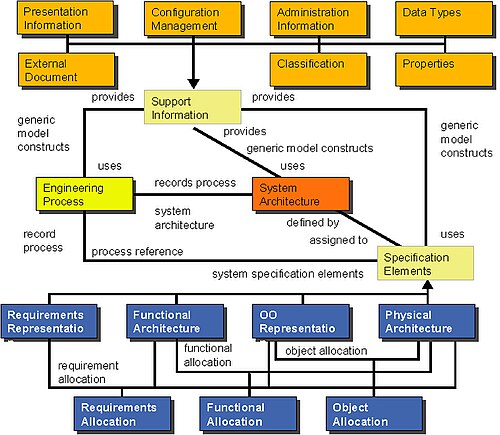AP233
AP233 is a standard for the exchange of systems engineering data. It is part of ISO 10303 .
AP233 offers a neutral, computer-readable data format for systems engineering data exchange between tools for product data management , computer-aided development (CAE or CAx), computer-aided system engineering (CASyE) and computer-aided software engineering (CASE).
At the moment the application protocol is only used for the sequential exchange of data between the tools. On the basis of AP233 it is possible to generate systems engineering data in a standardized and computer-readable format. This data can now be imported into other tools, regardless of the tool and manufacturer. The data exchange takes place on the basis of e-mail , FTP , Standard Data Access Interface (SDAI), XML etc.
AP233 (Application Protocol 233) in ISO 10303 includes the description of the information required for the systems engineering process. The scope of functions was specified by EIA / IS-632, among others. AP233 was developed between 1996 and 2001 and was funded by the EU.
The SEDRES (Systems Engineering Data Representation and Exchange Standard) project is being continued in the ISO working group ISO / TC-184 / SC4 / WG3 2 (see web link), with the aim of consistently modularising AP233. The aim is also to expand AP233 as part of the systems engineering concept, e.g. B. through functions of risk management.
The SEDRES-AP233 data model supports the following concepts:
- System and subsystem views including hierarchies
- Requirements: text- and model-based requirements tracking
- System behavior and functional architectures
- Functional decompositions, interfaces & assignments
- Functional & data flows; Behavior models; State machines
- System, functional, physical architecture and monitoring of the interfaces
- Component breakdown, interfaces and allocations
- Parts libraries and product lines
- System values, classifications and data definitions
- Systems engineering data management
- Model layout and display information
In an updated version of AP233, which is made up of modules, the following aspects are also supported:
- PDM aspects
- Life cycle aspects
- Risk analysis
With AP233 it is possible to develop gateways between the tools faster and cheaper . A standard is essential in order to facilitate and simplify the quality of information exchange in the systems engineering area. The life cycle for systems engineering projects is very often over 50 years from the creation of the requirements to the decommissioning. This is e.g. B. Much longer than the current age of CASE tools. Because of product liability , it is also necessary to have a tool-independent data format available so that the data can still be interpreted after 100 years. A long-term archiving of data is made possible by AP233.
The SysML standard uses AP233 for product data exchange.
Web links
- OFFICIAL TC184 / SC4 Web Site (English)
- STEP / ISO 10303 elements (English) ( Memento from May 25, 2011 in the Internet Archive )
